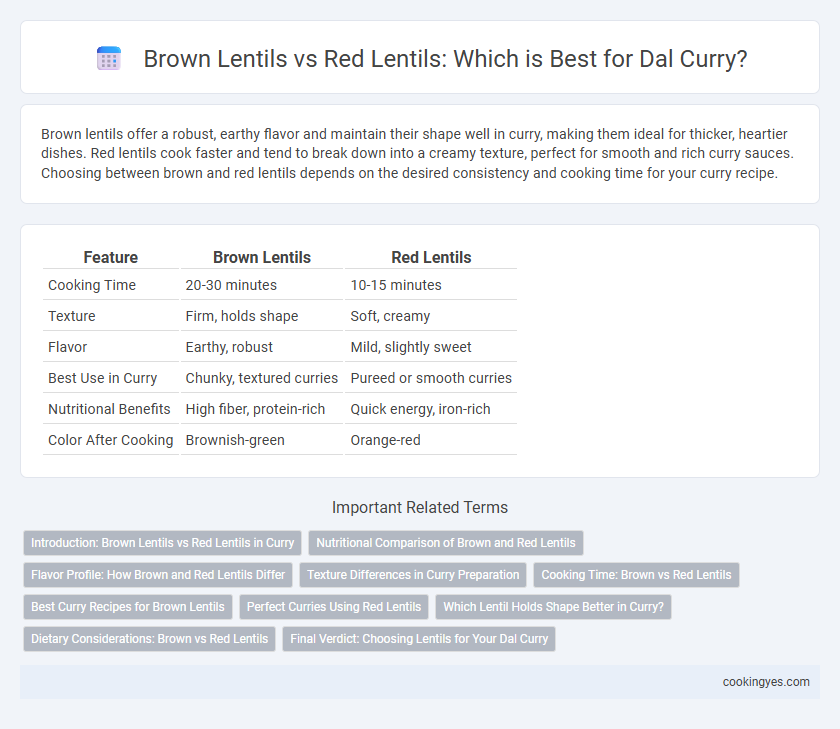Brown lentils offer a robust, earthy flavor and maintain their shape well in curry, making them ideal for thicker, heartier dishes. Red lentils cook faster and tend to break down into a creamy texture, perfect for smooth and rich curry sauces. Choosing between brown and red lentils depends on the desired consistency and cooking time for your curry recipe.
Table of Comparison
| Feature | Brown Lentils | Red Lentils |
|---|---|---|
| Cooking Time | 20-30 minutes | 10-15 minutes |
| Texture | Firm, holds shape | Soft, creamy |
| Flavor | Earthy, robust | Mild, slightly sweet |
| Best Use in Curry | Chunky, textured curries | Pureed or smooth curries |
| Nutritional Benefits | High fiber, protein-rich | Quick energy, iron-rich |
| Color After Cooking | Brownish-green | Orange-red |
Introduction: Brown Lentils vs Red Lentils in Curry
Brown lentils offer a firm texture and earthy flavor that hold up well in slow-cooked curries, making them ideal for rich, robust dishes. Red lentils, with their quick cooking time and soft, creamy consistency, blend seamlessly into smooth, spiced curry bases. Both varieties provide high protein and fiber content, enhancing the nutritional profile of traditional Indian dal recipes.
Nutritional Comparison of Brown and Red Lentils
Brown lentils contain higher fiber content and more iron, making them beneficial for digestive health and oxygen transport in the body. Red lentils cook faster and have more folate and vitamin B6, supporting cell function and energy metabolism. Both varieties offer rich plant-based protein and essential minerals, ideal for balanced, nutritious curries.
Flavor Profile: How Brown and Red Lentils Differ
Brown lentils have a mild, earthy flavor with a slightly nutty undertone that holds up well in robust curry dishes, while red lentils offer a sweeter and more delicate taste that blends seamlessly into creamy or spiced sauces. Brown lentils maintain their shape after cooking, adding a firm texture that complements hearty curries, whereas red lentils tend to break down quickly, creating a smooth, velvety consistency ideal for thickening soups and stews. The choice between brown and red lentils in curry recipes significantly affects both the flavor depth and texture, catering to different culinary preferences and regional traditions.
Texture Differences in Curry Preparation
Brown lentils maintain a firm texture when cooked, which holds up well in thick, hearty curries, providing a slightly nutty flavor and a more substantial bite. Red lentils break down quickly, resulting in a creamy, smooth consistency that blends effortlessly into the sauce, making them ideal for velvety, richly spiced curries. Choosing between brown and red lentils significantly affects the final curry texture, influencing whether the dish features distinct lentil grains or a silky, stew-like base.
Cooking Time: Brown vs Red Lentils
Brown lentils require a longer cooking time of about 30 to 45 minutes, maintaining their texture and shape well in curries. Red lentils cook much faster, typically in 15 to 20 minutes, and tend to break down, creating a smooth, creamy base ideal for thick curries. Choosing between brown and red lentils affects both the curry's texture and the overall cooking duration.
Best Curry Recipes for Brown Lentils
Brown lentils hold their shape well during cooking, making them ideal for hearty curry recipes that benefit from a firmer texture, such as traditional Indian dal or lentil stews with spices like cumin, coriander, and turmeric. Their earthy flavor pairs perfectly with robust ingredients like garlic, ginger, and garam masala, enhancing rich, savory curries that simmer slowly to develop depth. Unlike red lentils, which tend to break down into a creamy consistency, brown lentils are preferred in recipes requiring distinct lentil pieces for a satisfying bite and complex mouthfeel.
Perfect Curries Using Red Lentils
Red lentils are ideal for curries due to their quick cooking time and ability to break down into a creamy texture, creating rich, flavorful sauces. Their mild, slightly sweet flavor blends seamlessly with aromatic spices like turmeric, cumin, and coriander, enhancing the depth of traditional Indian and Middle Eastern dishes. Unlike brown lentils, which remain firm and grainy, red lentils ensure a smooth consistency perfect for silky dal curries.
Which Lentil Holds Shape Better in Curry?
Brown lentils hold their shape better in curry compared to red lentils, which tend to break down and become mushy during cooking. This resilience makes brown lentils ideal for dishes requiring distinct lentil texture and bite. Red lentils are preferred for creamy and smooth curry bases due to their faster cooking and soft consistency.
Dietary Considerations: Brown vs Red Lentils
Brown lentils contain higher fiber content, promoting better digestion and sustained energy release in curry dishes, while red lentils are lower in fiber and easier to digest, making them suitable for sensitive stomachs. Both lentil types are excellent sources of plant-based protein and essential minerals like iron and folate, supporting balanced nutrition in curries. Brown lentils have a lower glycemic index compared to red lentils, which may help regulate blood sugar levels when included in meals.
Final Verdict: Choosing Lentils for Your Dal Curry
Brown lentils offer a hearty texture and earthy flavor ideal for rustic dal curries, while red lentils cook faster and create a creamy, smooth consistency perfect for quick, comforting dishes. Nutritionally, both provide rich sources of protein, fiber, and essential minerals, but red lentils tend to be easier to digest due to their split form. For dal curry, choose brown lentils when you want a firmer bite and robust taste, and opt for red lentils for a softer, velvety curry that absorbs spices well.
Brown Lentils vs Red Lentils for Curry Infographic

 cookingyes.com
cookingyes.com